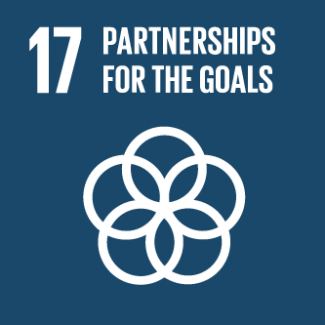Sustainable e-commerce





Business Model Description
Establishing and supporting e-commerce marketplaces that offer sustainably produced and locally-sourced consumption products ranging from food and beverages, cosmetics, textile and other such eco-friendly merchandise with integrated value chains
Expected Impact
This IOA will work towards building uninterrupted and digitalized supply chains for sustainable products and generate income for SMEs that are adversely affected by COVID-19.
How is this information gathered?
Investment opportunities with potential to contribute to sustainable development are based on country-level SDG Investor Maps.
Disclaimer
UNDP, the Private Finance for the SDGs, and their affiliates (collectively “UNDP”) do not seek or solicit investment for programmes, projects, or opportunities described on this site (collectively “Programmes”) or any other Programmes, and nothing on this page should constitute a solicitation for investment. The actors listed on this site are not partners of UNDP, and their inclusion should not be construed as an endorsement or recommendation by UNDP for any relationship or investment.
The descriptions on this page are provided for informational purposes only. Only companies and enterprises that appear under the case study tab have been validated and vetted through UNDP programmes such as the Growth Stage Impact Ventures (GSIV), Business Call to Action (BCtA), or through other UN agencies. Even then, under no circumstances should their appearance on this website be construed as an endorsement for any relationship or investment. UNDP assumes no liability for investment losses directly or indirectly resulting from recommendations made, implied, or inferred by its research. Likewise, UNDP assumes no claim to investment gains directly or indirectly resulting from trading profits, investment management, or advisory fees obtained by following investment recommendations made, implied, or inferred by its research.
Investment involves risk, and all investments should be made with the supervision of a professional investment manager or advisor. The materials on the website are not an offer to sell or a solicitation of an offer to buy any investment, security, or commodity, nor shall any security be offered or sold to any person, in any jurisdiction in which such offer would be unlawful under the securities laws of such jurisdiction.
Country & Regions
- Turkey: Marmara Region
Sector Classification
Technology and Communications
Development need
Technology is a cross-cutting sector for many SDGs. In terms of its performance on SDG 9 (Industry, Innovation and Infrastructure), Turkey faces major challenges. The country performs well-below the global long-term objective in indicators such as Expenditures on Research and Development and the Number of Researchers (per thousand employed people). (1)
Policy priority
The 11th Development Plan, the Sustainable Development Goals Evaluation Report, 2020 Annual Presidential Program and the 2019-2023 Strategy Plan of the Ministry of Industry and Technology all highlight the importance of technology for the achievement of the SDGs and stress the need to digitally transform the country’s economy as a prerequisite for competitive production.
Gender inequalities and marginalization issues
According to the Women in Tech Index, the percentage of female employment in technology is at a mere 9.91% in Turkey. 37.11% of STEM graduates are female. There is a gender pay gap of 8.42% between men and women in the tech industry. This necessitates policies and business models that promote the employment of women in technology with fair wages. (18)
Investment opportunities
The government intends to mobilize investment momentum in this sector. Existing incentives are offered by TUBITAK, KOSGEB, The Ministry of Industry and Technology and the Development and Investment Bank of Turkey. The importance of investing in this sector is increasingly evident with the outbreak of the COVID-19 pandemic, necessitating remote access to vital services
Key bottlenecks
The ability to compete on prices with imported technological products and services already present in the Turkish market; infant-industry problems. Ambiguity of the regulations in some of the latest areas of development such as IoT. Issues related to cyber security and data privacy.
Internet Media and Services
Development need
Turkey is on a track of improvement, but still faces significant challenges in SDG 9 indicators such as the % of population with mobile broadband subscriptions and the % population using the internet. COVID-19 has highlighted the need to utilize internet media and services to maintain economic activity and grant access to consumption products and essential services
Policy priority
Government’s campaign of “We are with SMEs as the E-Trade Industry (E-Ticaret olarak KOBİ’lerin Yanındayız)” supports SMEs and encourages e-trade companies’ contribution to the recovery from COVID-19's negative effects on trade
Gender inequalities and marginalization issues
In 2016, only 50% of women in Turkey were Internet users compared to 68% of men (19)
Investment opportunities
Ministry of Trade, KOSGEB, TÜBİTAK, İSTKA and TOBB provides loans and grants to the companies that are part of the e-trade sector
Key bottlenecks
Problems in the general population's access to the internet may present challenges in scaling this model. However, this is less of an issue in urban areas.
Internet Media and Services
Pipeline Opportunity
Sustainable e-commerce
Establishing and supporting e-commerce marketplaces that offer sustainably produced and locally-sourced consumption products ranging from food and beverages, cosmetics, textile and other such eco-friendly merchandise with integrated value chains
Business Case
Market Size and Environment
< USD 50 million
> 25%
Turkey's e-commerce market value is around $11.6 million. Sustainable e-commerce also becomes preferable as the trend of environmentally conscious consumption is popular among the millennial generation. (7)
A joint report by Turkey's Informatics Industry Association (TUBISAD), Deloitte Turkey, SimilarWeb and Inveon estimates the average annual growth rate of the e-commerce sector to be 35%, based on its performance in the past five years (8).
Indicative Return
20% - 25%
Investors and operators active in sustainable commerce and online shopping in Turkey estimate an IRR of 20% from investments in this field.
Investment Timeframe
Short Term (0–5 years)
62% of e-commerce businesses operating in Turkey and generating profits have been in the business for under 5 years.(9)
Ticket Size
USD 500,000 - USD 1 million
Market Risks & Scale Obstacles
Market - High Level of Competition
Market - High Level of Competition
Impact Case
Sustainable Development Need
The e-commerce industry has been growing rapidly and over-consumption is becoming a great threat considering the amount of waste created due to packaging, non-recyclables and single-use products.
Due to COVID-19, there is a transformation of lifestyles globally which increases the dependency on online services.
E-commerce might be able to provide SMEs and other enterprises with the opportunity to sell their products nationally and internationally, which will help grow their businesses and generate more jobs.
Gender & Marginalisation
Unequal access of female / rural population / immigrant led businesses to traditional consumption channels and employment gaps in these groups
Women owned businesses represent 40% of small and medium enterprises (SMEs) in Turkey (20). SMEs and entrrepreneurs who have limited digital connectivity are severely impacted by COVID-19
Expected Development Outcome
Reduce the over-consumption risk of conventional e-commerce.
Reduce the generation of waste and support the circular economy by encouraging sustainable production and consumption cycles
Ameliorate the damage COVID-19 inflicted on trade by bolstering sustainable e-commerce options and contributing to the growth of SMEs by encouraging digital transformation.
Gender & Marginalisation
E-commerce will boost the economic activity and sales of female-owned MSMEs
E-commerce can increase the number of female-owned businesses
E-commerce can help foster rural development by empowering rural producers to market and sell their products, or purchase intermediary products for their businesses ie. agricultural producers, smallholder farms, village factories, producers of local crafts
Primary SDGs addressed

8.4.2 Domestic material consumption, domestic material consumption per capita, and domestic material consumption per GDP
18.5 tonnes per capita (10)

12.1.1 Number of countries developing, adopting or implementing policy instruments aimed at supporting the shift to sustainable consumption and production
12.2.1 Material footprint, material footprint per capita, and material footprint per GDP
12.2.2 Domestic material consumption
1 (10)
12.18 tonnes per capita (global) (10)
18.5 tonnes per capita (10)
Secondary SDGs addressed



Directly impacted stakeholders
People
Gender inequality and/or marginalization
Planet
Corporates
Indirectly impacted stakeholders
People
Corporates
Outcome Risks
Overconsumption might be a negative externality of this model due to easy and increased access to commercial products.
Impact Risks
Stakeholder risk Unexpected impact risk
Impact Classification
What
Important, positive outcome: increased eco-friendly consumption.
Who
This model is likely to generate positive impact for SMEs, local farmers, raw-material producers and customers.
Risk
Low-level of impact risk: If the local producers are not adequately integrated into the supply-chain/ if the relative ease of consumption increases wasteful habits (external damage)
Impact Thesis
This IOA will work towards building uninterrupted and digitalized supply chains for sustainable products and generate income for SMEs that are adversely affected by COVID-19.
Enabling Environment
Policy Environment
(11th Development Plan): The 11th Development Plan aims to adopt awareness raising activities to promote conscious consumption.
The Government’s campaign of “We are with SMEs as the E-Trade Industry (E-Ticaret olarak KOBİ’lerin Yanındayız)” supports SMEs and encourages e-trade companies’ contribution to the recovery from COVID-19's negative effects on trade. (11)
(2020 Presidential Programme): The 2020 Presidential Programme recommends increasing the digital literacy of entrepreneurs and declares that technology development centers will be established for entrepreneurs in priority investment areas
Financial Environment
Financial incentives: Ministry of Trade, KOSGEB, TÜBİTAK, İSTKA and TOBB provides loans and grants to the companies that are part of the e-trade sector.
Other incentives: Decision on Supporting Digital Activities at Market Entry provides incentives such as the coverage of membership fees, virtual trade delegation support, participation support for virtual fairs, virtual fair organization support and other financial support schemes.
Regulatory Environment
(Regulation): Law on Regulation of Electronic Commerce (Act No. 6563) (E-commerce Law) stipulates the obligations of operators of electronic commerce websites.
(Regulation): Law on Consumer Protection (Act No. 6502) sets out the rules of all consumer – business/seller interactions.
(Regulation): The new Personal Data Protection Law of 2019 outlines the requirements and criteria for data protection in online systems for Turkey
Marketplace Participants
Private Sector
E-payment companies, cargo companies, packaging companies, domestic and international banks
Government
The Ministry of Trade, KOSGEB, Tübitak, İSTKA
Non-Profit
TOBB, NGOs similar to CarbonFund
Target Locations
Turkey: Marmara Region
References
- ("1) SDG Index & Dashboard, 2020, https://dashboards.sdgindex.org/profiles/TUR/indicators " "2) 11th Development Plan http://www.sbb.gov.tr/wp-content/uploads/2020/03/On_BirinciPLan_ingilizce_SonBaski.pdf " "3) 2020 Annual Presidential Program, http://www.sbb.gov.tr/wp-content/uploads/2019/11/2020_Yili_Cumhurbaskanligi_Yillik_Programi.pdf " "4) Sustainable Development Goals Evaluation Report, http://www.surdurulebilirkalkinma.gov.tr/wp-content/uploads/2020/03/Surdurulebilir-Kalkinma-Amaclari-Degerlendirme-Raporu_13_12_2019-WEB.pdf "
- (5) The 2019-2023 Strategy Plan of the Ministry of Industry and Technology, https://www.sanayi.gov.tr/strateji2023/sts-ktp.pdf
- (6) E-Ticaret, 2020, https://www.eticaret.gov.tr/haberler/35/detay
- (7) JP Morgan, 2019. 2019 Global Payments Trends Report - Turkey Country Insights. https://www.jpmorgan.com/merchant-services/insights/reports/turkey "8) Anadolu Ajans, Turkey's e-commerce volume boost 39% in 2019, https://www.aa.com.tr/en/economy/turkeys-e-commerce-volume-boost-39-in-2019/1822760 "
- (9) Dopigo, 2018. Second E-Commerce Outlook in Turkey. https://www.dopigo.com/ikinci-e-ticaret-gorunum-arastirmasi/
- (10) SDG Tracker, 2020, https://sdg-tracker.org/
- (11) E-ticaret Bilgi platformu, E-ticaret Olarak KOBİ'lerin Yanındayız. https://www.eticaret.gov.tr/haberler/35/detay "12) Official Gazette, E-Ticaret ve Hizmet Yönetmeliği. https://www.resmigazete.gov.tr/eskiler/2015/08/20150826-10.htm "
- (13) Official Gazette, 27 May 2020, Pazara Girişte Dijital Faaliyetlerin Desteklenmesi Hakkında Karar. https://www.resmigazete.gov.tr/eskiler/2020/05/20200527-15.pdf "14) Milliyet Daily, 2019. https://www.milliyet.com.tr/pembenar/tek-kullanimlik-plastik-yasagi-basliyor-mu-2881679 " "15) Simya Geri Dönüşüm, Tekstil Atıkları Raporu, http://simyageridonusum.com/?page_id=1293 " "16) Argumadan Consultancy, Investment and Incentive Applications in E-Trade in 5 Steps http://www.argumadanismanlik.com/5-adimda-e-ticarette-yatirim-ve-tesvik-uygulamalari/ "
- (17) PwC, https://www.pwc.com.tr/tr/hizmetlerimiz/vergi/dolayli-vergi/bultenler/yatirim-tesvik-bultenleri/2020/pazara-giriste-dijital-faaliyetlerin-desteklenmesi-hakkinda-karar.html
- (18) Honeypot, Women in Tech Index, 2018 https://www.honeypot.io/women-in-tech-2018/
- (19) OECD, Women in the Digital Era: Internet Use and Skills at Work, https://www.oecd.org/gender/data/women-in-the-digital-era-internet-use-and-skills-at-work.htm
- (20) International Finance Corporation, 2014, https://www.ifc.org/wps/wcm/connect/news_ext_content/ifc_external_corporate_site/news+and+events/news/backing+women+entrepreneurs+in+turkey















